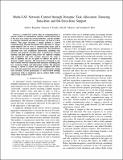| dc.contributor.author | Kopeikin, Andrew | |
| dc.contributor.author | Ponda, Sameera S. | |
| dc.contributor.author | Johnson, Luke B. | |
| dc.contributor.author | How, Jonathan P. | |
| dc.date.accessioned | 2013-10-25T13:26:52Z | |
| dc.date.available | 2013-10-25T13:26:52Z | |
| dc.date.issued | 2012-12 | |
| dc.identifier.isbn | 978-1-4673-4941-3 | |
| dc.identifier.isbn | 978-1-4673-4942-0 | |
| dc.identifier.isbn | 978-1-4673-4940-6 | |
| dc.identifier.uri | http://hdl.handle.net/1721.1/81768 | |
| dc.description.abstract | A multi-UAV system relies on communications to operate. Failure to communicate remotely sensed mission data to the base may render the system ineffective, and the inability to exchange command and control messages can lead to system failures. This paper describes a unique method to control communications through distributed task allocation to engage under-utilized UAVs to serve as communication relays and to ensure that the network supports mission tasks. The distributed algorithm uses task assignment information, including task location and proposed execution time, to predict the network topology and plan support using relays. By explicitly coupling task assignment and relay creation processes the team is able to optimize the use of agents to address the needs of dynamic complex missions. The framework is designed to consider realistic network communication dynamics including path loss, stochastic fading, and information routing. The planning strategy is shown to ensure that agents support both datarate and interconnectivity bit-error-rate requirements during task execution. System performance is characterized through experiments both in simulation and in outdoor flight testing with a team of three UAVs. | en_US |
| dc.description.sponsorship | Aurora Flight Sciences Corp. (Fellowship Program) | en_US |
| dc.language.iso | en_US | |
| dc.publisher | Institute of Electrical and Electronics Engineers (IEEE) | en_US |
| dc.relation.isversionof | http://dx.doi.org/10.1109/GLOCOMW.2012.6477821 | en_US |
| dc.rights | Creative Commons Attribution-Noncommercial-Share Alike 3.0 | en_US |
| dc.rights.uri | http://creativecommons.org/licenses/by-nc-sa/3.0/ | en_US |
| dc.source | MIT web domain | en_US |
| dc.title | Multi-UAV network control through dynamic task allocation: Ensuring data-rate and bit-error-rate support | en_US |
| dc.type | Article | en_US |
| dc.identifier.citation | Kopeikin, Andrew, Sameera S. Ponda, Luke B. Johnson, and Jonathan P. How. “Multi-UAV network control through dynamic task allocation: Ensuring data-rate and bit-error-rate support.” In 2012 IEEE Globecom Workshops, 1579-1584. Institute of Electrical and Electronics Engineers, 2012. | en_US |
| dc.contributor.department | Lincoln Laboratory | en_US |
| dc.contributor.department | Massachusetts Institute of Technology. Aerospace Controls Laboratory | en_US |
| dc.contributor.department | Massachusetts Institute of Technology. Department of Aeronautics and Astronautics | en_US |
| dc.contributor.mitauthor | Kopeikin, Andrew | en_US |
| dc.contributor.mitauthor | Ponda, Sameera S. | en_US |
| dc.contributor.mitauthor | Johnson, Luke B. | en_US |
| dc.contributor.mitauthor | How, Jonathan P. | en_US |
| dc.relation.journal | Proceedings of the 2012 IEEE Globecom Workshops | en_US |
| dc.eprint.version | Author's final manuscript | en_US |
| dc.type.uri | http://purl.org/eprint/type/ConferencePaper | en_US |
| eprint.status | http://purl.org/eprint/status/NonPeerReviewed | en_US |
| dspace.orderedauthors | Kopeikin, Andrew; Ponda, Sameera S.; Johnson, Luke B.; How, Jonathan P. | en_US |
| dc.identifier.orcid | https://orcid.org/0000-0001-8576-1930 | |
| dc.identifier.orcid | https://orcid.org/0000-0001-6084-7287 | |
| mit.license | OPEN_ACCESS_POLICY | en_US |
| mit.metadata.status | Complete | |
